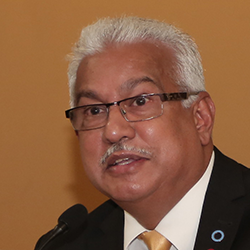By Kevon Felmine
Although the public health system was plagued by drug shortages, overcrowding at hospitals and the Zika virus pandemic during 2016, Health Minister Terrence Deyalsingh said it was the best year for maternal mortality and influenza.
He is promising that 2017 will be even better as he plans to reduce waiting times for patients at public health institutions and strengthen the supply of drugs.
Deyalsingh spoke with reporters during his visit to the San Fernando General Hospital yesterday to congratulate the women who gave birth to the first babies of 2017 at that institution.
The minister said there were only three maternal deaths last year and after the Pan American Health Organisation (PAHO) was invited to audit the country’s health systems, it was discovered that postpartum haemorrhage was the main cause of such deaths.
He said strengthen maternity care, PAHO-trained local obstetricians, nurses and midwives on postpartum haemorrhage, resulting in the lives of three mothers being saved through implementation of new protocols and measures.
“I had challenged the public health system that by the year 2020 our maternal mortality rate should match that of developed countries,” Deyalsingh said.
“That means that we measure maternal mortality in developed countries as 30 maternal deaths per 100,000 live births.
“That is the rate for developed countries worldwide.
“If we scale that down to Trinidad and Tobago, where we have between 17,000 to 20,000 live births per year, it means in Trinidad and Tobago you should not have more than three to four maternal deaths per year.
“I had challenged the public health system to work with me to achieve that by 2020, but we have achieved that in 2016, so we are already at developed country status in 2016.
“We are collectively ahead of the schedule. It just goes to show what policy intervention can do.
“I am so pleased to report to the country of these great strides.”
He said new protocols on Caesarian-sections will be developed for all regional health authorities and will be institutionalised as best practice.
While the infant mortality rate is declining, the minister said there is a problem in how it is measured in T&T.
The minister said a team has been set up to standardise the reporting of infant mortality.
According to the minister, the infant mortality rate at the Port-of-Spain General Hospital went down by 50 per cent between January and July 2016 over the same period in 2015.
He said figures on the Zika virus have “more of less plateaued” at 460 infections and after numerous complaints about the ambulance service, it has been greatly improved.
In 2015, at least four people died from the H1Ni (Swine flu) influenza. However, with flu vaccine protocols being introduced last year, there were no influenza deaths.
“I want to build on those successes for 2017 to start to look at things like waiting times.
“We as a country must have waiting times which are more acceptable and more patient focused.
“We have made great strides in the past few months in tackling the drug supply system.
“We are going to work that even harder in 2017,” Deyalsingh said.(Trinidad Guardian)














